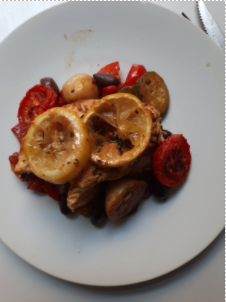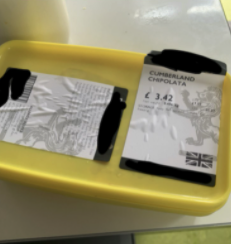Keep Calm and Carry On: Our reflections on participating in Plastic-Free July
Posted on

This is coming to an end. What a relief. It’s not been easy. At times it’s reminded us of parental stories about World War 2 austerity - few luxuries or treats and a considerably restricted diet compared to our norm. Probably not as healthy as the WW2 UK diet has been claimed to be though - it’s been surprisingly difficult to put together a varied and healthy diet this month. Where we live is lacking traditional greengrocers, with limited market stalls selling fruit and vegetables, and it’s clear the supermarkets have a long way to go in the pursuit of plastic-packaging free shopping.
That’s been one of the most striking things about this exercise - when you scan the supermarket shelves with newly plastic-sensitive eyes you realise the efforts of the supermarkets to reduce plastic use are tiny in proportion to the amount of plastic. It’s startling to see how dominant the use of plastic packaging for food has become. Even products which are apparently plastic-free can have hidden plastic in their packaging - the tops of glass jars and bottles, the stickers on loose fruit and vegetables, the rims of those ice cream cartons that otherwise appear to be cardboard. And are those transparent panels in the loose bread bags biodegradable or not?
We did find some supermarkets making efforts to reduce plastic - Waitrose, Booths, Sainsburys and Morrisons, for example, all have various plastic-free initiatives in progress, but not yet enough to have a real impact on household food planning. And as well as the everyday problems of finding plastic-free food supplies, we often found it difficult to make informed choices. This was particularly noticeable online, where product descriptions might include only cursory details of how products are packaged and whether these packages are recyclable or not. Even where information was available it wasn’t necessarily helpful. And it soon becomes apparent that there are too many complex issues to calculate for every product. If you want to balance health considerations, plastic use, environmental concerns and other factors such as raw materials provenance and local production and family tastes….you have a complex problem. Making decisions on the hoof was difficult in this context. We often found ourselves using simple procedures and heuristics - buy bulk, look for recycling details on packaging (things aren’t always what they seem), buy things in reusable plastic containers, not single use plastics. But even with such guidance it’s probable that there are too many factors involved to make rational choices. Add to this the pressure of having to visit 2-3 different stores to get your shopping, and for some of us shopping started to feel more stressful than it needed to be.
Other interesting things - trying to go plastic-free is for many people likely to be situated in a wider social context. Friends and family can be supportive, or not. The pressures of time, family preferences (“Does that mean I can’t have chicken for a whole month?”, to quote a young family member), and the fresh problems presented by social events whether at home or out and about all matter. One of us had family visiting, and it was a big deal, given that we’ve faced all these restrictions over the last 16 months. Apart from going to great lengths to ensure that a suitably celebratory plastic-packaging free meal was prepared (slow cooked beef shin ragu, meat purchased from the butcher's counter, packaged in containers from home), it was fascinating the lengths visitors went to, to help us stick to our plastic-free promise. The famous “Nonna’s Pizza” made its way to Lancaster from Glasgow, wrapped in tea-towels and cloths, rather than the usual single-use plastic clingfilm.

Figure 1. Plastic Free Dinner, with Chicken

Figure 2. Nonna’s Pizza, wrapped in clothes, rather than clingfilm
We hadn’t really expected or prepared for the social problems associated with making our plastic-free purchases. One family member speaking before he did the weekly shop, said:
“I’m feeling a bit anxious, not quite sure what kind of reaction I’m going to get, whether it’s something that’s really unusual for them, or whether they are used to dealing with this kind of thing already. Thinking about the slowness of the process, whether it gets people upset who are queuing behind me, things like that.”
For another group member, it was a similar experience:
“The Deli counter, the woman was a bit stressed as there was a queue growing and I had a list of 5 things to get. I asked for no plastic, and she was very accommodating and wrapped the items in the paper used for cheese. Her colleague came over and, rather abruptly, informed the woman that she should not be wrapping sliced meat in cheese paper – when the lady informed her that the customer had asked, I said I am more than happy to have these put in my boxes rather than use the paper. To which she looked annoyed and said they could not do that because the Deli counter food was cooked. I asked why raw produce could be put in a container, reply “you cook that” – so I am guessing no recourse in terms of salmonella etc.”

Figure 3. Meat packaged in recycled plastic boxes from home
With more practice at asking for plastic-free goods, these awkward scenarios started to ease, but it took practice and commitment to the cause to keep going. Travelling and going out to eat and drink also added new challenges (dealing with plastic wrapped fruit on planes; trying to find water fountains to refill our bottles), and many of us found we couldn’t quite manage plastic-free in these contexts. This is not ideal, of course, but reinforced the point that a whole system approach is needed to support individuals trying to go plastic-free.
Looking ahead and the changes we will stick with, most of us have said we’ll try to keep going with some of the changes. Where equipment was purchased (SodaStream; yoghurt maker), then certainly there is a commitment to stick with that change. Buying plastic-packaging free produce from the butchers and Deli counters will continue for some of us, as overall, this is relatively straightforward to do. On the milk front, team-members who had moved to milk delivery are planning to stick with it, even though it is more expensive. The increased cost and effort of shopping plastic-free was noted by many of us, with one saying: “It’s really difficult to go ‘plastic-free’ especially when it comes to everyday products and purchases”. Overall, we found it to be a significant commitment in terms of time, resources, and energy, and felt like a ‘luxury’ that only a handful of people can attend to on a daily basis.
Authors: Prof. Maria Piacentini, Dr Alison Stowell, Dr Alex Skandalis, Dr John Hardy, Prof. Linda Hendry, Dr James Cronin, Dr Charlotte Hadley, Dr Matteo Saltalippi and Dr Savita Verma.
Related Blogs
Disclaimer
The opinions expressed by our bloggers and those providing comments are personal, and may not necessarily reflect the opinions of Lancaster University. Responsibility for the accuracy of any of the information contained within blog posts belongs to the blogger.
Back to blog listing




